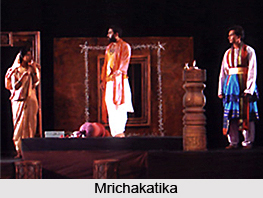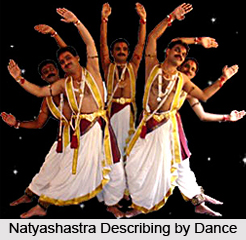 Actors and actresses are the main driving force of Sanskrit drama. The characters in Sanskrit drama are categorised on the basis of superior (uttama), medium (madhyama) and third rate (adhama) actors. There is great variety of characters, male and female, introduced in Sanskrit plays. Kings, ministers, high officials and attendants often figured very significantly. There are detailed instructions given by theorists regarding the persons appearing on stage.
Actors and actresses are the main driving force of Sanskrit drama. The characters in Sanskrit drama are categorised on the basis of superior (uttama), medium (madhyama) and third rate (adhama) actors. There is great variety of characters, male and female, introduced in Sanskrit plays. Kings, ministers, high officials and attendants often figured very significantly. There are detailed instructions given by theorists regarding the persons appearing on stage.
Heroes (nayaka) are of different kinds according to their qualities. They are light-hearted (lalita), calm (santa), exalted {udatta) or vehement (uddhata). The self controlled and light hearted hero, dhiralalita, was free from anxiety, fond of the arts, happy and gentle. The hero in the Ratnavali is an instance of the dhiralalita hero. The self controlled and calm hero, dhirasanta, is a Brahmana or possessed of the generic qualities of a hero. The heroes in the play Malatimadhava and the Mrichakatika are instances of this kind.
The self-controlled and dignified hero, dhirodatta, is of great distinction, exceedingly sombre, forbearing, not arrogant, determined, and self-confident and focused, for example, the heroes in the Mahanataka and the Abhijnanasakuntalam. The self-controlled and passionate hero, dhirodhata, is dominated by arrogance and jealousy, devoted to witchcraft and treachery, self-assertive, inconsistent, irascible and boastful. There are rare instances of heroes of this type.
At times the hero has an antagonist and he is the pratinayaka. He is avaricious, stubborn, criminal and vicious like the dhiroddhata hero. His character is always portrayed as passionate and evil minded. Examples of pratinayakas are Ravana, the opponent of Lord Rama and Duryodhana, the opponent of Yudhisthir. The pleasure companion of the hero is addressed as the pithamarda. He is devoted to the hero and is the hero of an episode. Sugriva in the Ramayana and Makaranda in the Malatimadhava belong to this class. According to the Natyashastra, vita (parasite) is familiar with the ways of courtesans, sweet-tempered, impartial, poetic, able to argue, eloquent and clever. He is friendly in society and well versed in arts. According to Vatsyayana, the vita is a character who misuses his possessions. In dramas like Mrichakatika, the vita plays an imperative role.
 Vidusaka or the joker is the most important stock character in Indian theatre. He is a Brahmana and is described bald-headed, hunch-backed, and dwarfish, has protruding teeth, an imprecise mouth and yellow eyes. He is dressed in rags and skin. He is fond of squabbles and takes delight in eating and drinking. His external appearance, dress and way of walking are meant to evoke laughter. He is a faithful companion of the hero, who seeks his help at times of difficulties. The Sakara is an old, popular character and is the brother-in-law of the king. He is irritated without any reason and again appeased, wears gorgeous clothes and jewels, gladly boasts of his high associations, but all through portrays himself as uninformed and disgraceful. Among the other acquaintances of the hero is the ceta or the slave. The Natyashastra states that the ceta is quarrelsome, talkative, physically deformed and knows whom to respect and whom not. The commander in chief (senapati), the successor to the throne (kumara), the different ministers (mantrin, saciva, amatya), the judges (pradvivaka), messengers to distant places (duta) and the court priest (purohita) comes under the more distant or outer circle of acquaintances.
Vidusaka or the joker is the most important stock character in Indian theatre. He is a Brahmana and is described bald-headed, hunch-backed, and dwarfish, has protruding teeth, an imprecise mouth and yellow eyes. He is dressed in rags and skin. He is fond of squabbles and takes delight in eating and drinking. His external appearance, dress and way of walking are meant to evoke laughter. He is a faithful companion of the hero, who seeks his help at times of difficulties. The Sakara is an old, popular character and is the brother-in-law of the king. He is irritated without any reason and again appeased, wears gorgeous clothes and jewels, gladly boasts of his high associations, but all through portrays himself as uninformed and disgraceful. Among the other acquaintances of the hero is the ceta or the slave. The Natyashastra states that the ceta is quarrelsome, talkative, physically deformed and knows whom to respect and whom not. The commander in chief (senapati), the successor to the throne (kumara), the different ministers (mantrin, saciva, amatya), the judges (pradvivaka), messengers to distant places (duta) and the court priest (purohita) comes under the more distant or outer circle of acquaintances.
Instructions regarding the different types of heroines (nayika), their qualities, situations and relation to the hero are also available. The nayika may be divine women (divya), queens (nripapatni), women of good family (kulastri) or courtesans (ganika). In their relation to the hero, they may belong to him (sviya), to another (anya), or to all (sadharani). The sviya type of heroine if found in the Uttararamacarita, who is Sita, the wife of Lord Rama. An anya heroine is either a maiden or a married woman. A Married woman should never figure in the principal sentiment, but love for a maiden could be represented in relationship with the principal or the secondary sentiments. In Ratnavali and Malatimadhava there are instances of the anya type of heroine like in the love of Vatsaraja for Sagarika in the former and Madhava`s love for Malati in the later. In the sadharanastri type of heroines, falls the courtesan. The Mrichakatika to a distinct class of very highly accomplished ganikas or courtesans and Vasantasena, a dancing girl, is introduced as in accomplished heroine with commendable traits of character.
Next to the heroines come their friends, step-sisters, maids and members of the harem. The Natyashastra describes them as constituting the inner circle (abhyantaragana). The principal queen (mahadevi), the second queen (devi), and old woman (vriddha) belongs to this class. In addition to these, there are woman body-guards (sancatika), women waiting on the king (anucarika), the heroine`s personal maids (paricarika) and the door keeper (pratihari). A third category of roles is also there known as napumsaka (neuter). Bharata in his Natyashastra includes learned and skilled Brahmanas (snataka), chamberlains (kancukiya) and eunuchs (varsadhara, nirmunda, aupasthayika) in this class.




















